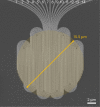Fast single-photon detectors and real-time key distillation enable high secret-key-rate quantum key distribution systems
- PMID: 37162797
- PMCID: PMC10162938
- DOI: 10.1038/s41566-023-01168-2
Fast single-photon detectors and real-time key distillation enable high secret-key-rate quantum key distribution systems
Abstract
Quantum key distribution has emerged as the most viable scheme to guarantee information security in the presence of large-scale quantum computers and, thanks to the continuous progress made in the past 20 years, it is now commercially available. However, the secret key rates remain limited to just over 10 Mbps due to several bottlenecks on the receiver side. Here we present a custom multipixel superconducting nanowire single-photon detector that is designed to guarantee high count rates and precise timing discrimination. Leveraging the performance of the detector and coupling it to fast acquisition and real-time key distillation electronics, we remove two major roadblocks and achieve a considerable increase of the secret key rates with respect to the state of the art. In combination with a simple 2.5-GHz clocked time-bin quantum key distribution system, we can generate secret keys at a rate of 64 Mbps over a distance of 10.0 km and at a rate of 3.0 Mbps over a distance of 102.4 km with real-time key distillation.
Keywords: Quantum information; Quantum optics.
© The Author(s) 2023.
Conflict of interest statement
Competing interestsThe authors declare no competing interests.
Figures






References
-
- Bennett CH, Brassard G. Quantum cryptography: public key distribution and coin tossing. Theor. Comput. Sci. 2014;560:7–11. doi: 10.1016/j.tcs.2014.05.025. - DOI
-
- Rivest RL, Shamir A, Adleman L. A method for obtaining digital signatures and public-key cryptosystems. Commun. ACM. 1978;21:120–126. doi: 10.1145/359340.359342. - DOI
-
- Koblitz N. Elliptic curve cryptosystems. Math. Comput. 1987;48:203–209. doi: 10.1090/S0025-5718-1987-0866109-5. - DOI
-
- Shor PW. Polynomial-time algorithms for prime factorization and discrete logarithms on a quantum computer. SIAM J. Comput. 1997;26:1484–1509. doi: 10.1137/S0097539795293172. - DOI
LinkOut - more resources
Full Text Sources
Miscellaneous
